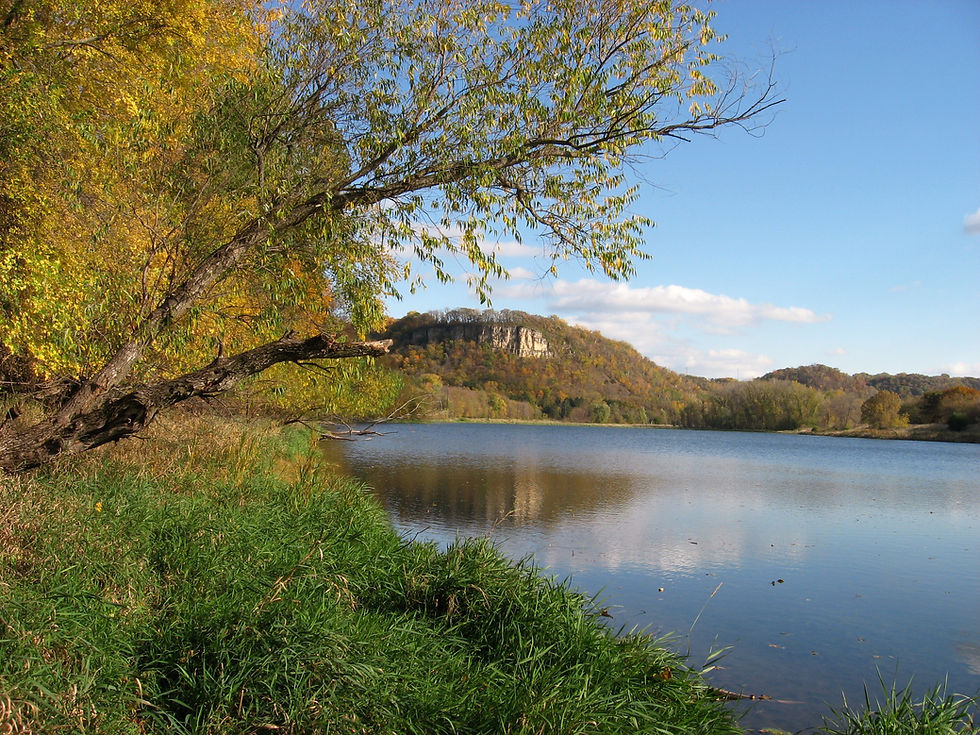Crazy Fall (Winter?) Weather
- wacoutanaturenotes
- Nov 8, 2020
- 4 min read
Updated: Nov 9, 2020

Peak Color Around Wacouta Bay
On October 8th, I made my last canoe outing for the year as I paddled from Red Wing to Presbyterian Point at the Head of Lake Pepin. With the river level at 2.9 feet, conditions were ideal for numerous flocks of American White Pelicans as they rested and feasted on small forage fish in the shallow backwaters.
I observed this good sized flock resting on a sandbar at the edge of Wacouta Bay. In the background, the north-facing bluff is adorned with impressive peak fall colors.

Fresh Snow on Colorful Bluff
On October 20th, we were ambushed by 6 to 8 inches of wet heavy snow. One wonders how trees in peak colors are impacted by this unusual cold weather. Fortunately, trees have a very reliable reference point as they begin their preparation for winter.
The cue is the diminishing length of daylight in late summer and early fall. With those changing light conditions, trees begin a hardening off process by increasing cell permeability allowing pure water to flow out, a syrupy solution of sugars, proteins and acids are left behind. Essentially a form of anti-freeze is left behind.
Death due to frost damage or unexpected snow is actually very low.

Tundra Swans Near Brownsville, MN
Following the unexpected snow, the temperatures for the next week broke numerous low records across the state. In response to these cold temperatures, I observed an impressive number of flocks of tundra swans heading south-southeast on their 1600 mile migration to the east coast including Chesapeake Bay.
According to biologists at the Upper Mississippi River National Wildlife Refuge in LaCrosse, upwards of 50,000 swans utilize the refuge on their migration for resting and feeding. Unfortunately with a lack of food in the Red Wing area, these birds rarely stop in our backwaters.
The best locations to observe the swans are the Weaver Bottoms near Weaver and the backwaters near Brownsville, Minnesota. This particular movement of swans was two weeks earlier than normal.

Wacouta Ponds During Summer of 2019
As you might recall from my posts from the summer of 2019, the water levels in Wacouta Pond and the smaller pond at the base of Rattlesnake Bluff were unusually high. This was primarily due to the fact the river remained high for an extended period of time.
I have learned that when Minnesota Highway 61 was rerouted between Red Wing and Frontenac many years ago, the smaller pond was created as a gravel borrow pit for that project.

Low Water Level on Small Pond
On October 28th, I was hiking near the base of the bluff and discovered the water level in the small pond was extremely low. What an amazing contrast to last summer.
This reality is due to the extended period of dry weather this summer and low river levels since early summer. Given the fact that this area of Wacouta is mostly sand and gravel, water easily drains out of the pond.

Gravel Remnants
As I was walking around the dry perimeter of the pond, I happened upon a pocket of large rocks. I can understand why such material would have been useful in strengthening the base for a new road bed.

Wacouta Pond Freezes Over
With the stretch of cold weather following the October 20th snowfall, Wacouta Pond finally became ice covered on the night of October 25th. This date is a good ten days premature from recent seasons. It will no doubt open up again with the warm temps predicted for the first week of November.

Muskrat Runway and Den
I recently received a letter from a former ELC participant who lives in Princeville, Hawaii in which a compliment was made for Wacouta Nature Notes. Craig Saupe lived in Wacouta when Kathy and I moved to Red Wing in 1970. In addition to his involvement at the ELC, Craig was an enthusiastic muskrat trapper earning money to help pay for his college education.
In Craig's letter, I was asked if muskrats were still observed in Wacouta Pond? The short answer was rarely. The main reason being a total lack of food desired by these furbearers. In the 1970's, the aquatic plant elodea was prolific and available for them to eat. In 2020, little can be found anywhere in the pond.
Surprisingly as I was walking along the shore on the north side of the pond, I did encounter a lone muskrat den and runway travelling under the ice.

Trumpeter Swans
As I was finishing up my morning walk on the Rattlesnake Bluff Trail on the 31st of October , I heard the distinct trumpeting call of swans heading towards me. Before I knew it, a beautiful flock of 14 swans was directly overhead.
While the tundra swans are in the midst of their migration to the east coast, Trumpeter swans are native to this area and stay here all year around. It is quite common for me to observe three or four in a group at the Head of the Lake, but rarely large numbers.
With winter approaching, these birds will sometimes congregate in areas of open water. Two of the best places to observe these groups locally are Bay City and the viewing area at Lock and Dam #3 on Prairie Island.




Didn't see December/January blog updates?
... the waterlevel picture of the small pond - wow... that was really low - is everything else very dry?
So many nice photos! I had to hunt a bit for this invite - but was able to log in via the FB/Messenger post that Karla put out.